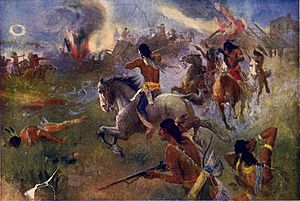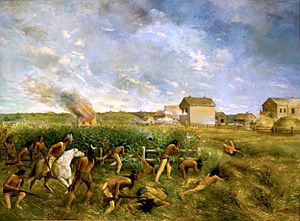Battles of New Ulm facts for kids
Quick facts for kids Battles of New Ulm |
|||||||
|---|---|---|---|---|---|---|---|
| Part of the Dakota War of 1862 | |||||||
 The Siege of New Ulm, Minnesota on August 19, 1862 |
|||||||
|
|||||||
| Belligerents | |||||||
| Santee Sioux | |||||||
| Commanders and leaders | |||||||
| Jacob Nix (first battle) Charles Roos (first battle) Charles Eugene Flandrau (second battle) |
Joseph Godfrey (first battle) Little Crow Mankato Big Eagle |
||||||
| Strength | |||||||
| 20–55 (first battle) 300 (second battle) (not including some 2,000 unarmed elderly, women, and children) | 100 (first battle), 650 (second battle) |
||||||
| Casualties and losses | |||||||
| 5 killed and 6 wounded (first battle) 34 (second battle) (Flandrau reported casualties as 10 killed and 50 wounded) |
Unknown | ||||||
The Battles of New Ulm were two important fights in August 1862. They happened between Dakota warriors and European settlers and soldiers in New Ulm, Minnesota. These battles were a big part of the Dakota War of 1862. Dakota forces attacked New Ulm twice. After the second attack, the town was emptied for safety.
Contents
Where Did the Battles Happen?
In 1862, New Ulm, Minnesota, was home to about 900 people. It was the largest town close to the Sioux reservation. After another fight at Battle of Fort Ridgely, New Ulm was seen as a possible target for a Dakota attack.
The land around New Ulm was tricky. It rose about 200 feet from the Minnesota River valley. This rise happened in two big steps, like terraces. There were also wooded areas. These features gave the Dakota good places to hide and plan an attack.
Why the Battles Happened
In 1851, the Santee Dakota people in Minnesota had to give up a huge amount of their land to the government. In 1852, they were moved to a reservation along the Minnesota River. Later, in 1858, they lost half of that land too.
By August 1862, the government had not paid the Dakota the money they were promised in treaties. Also, many supplies that were supposed to be given to them did not arrive. This caused great hardship and anger among the Dakota people.
Leaders in Minnesota, like Governor Alexander Ramsey, wanted all Dakota people to leave Minnesota. This added to the growing tensions.
The First Attack on New Ulm
On August 18, 1862, Dakota warriors began attacking people in Milford Township, Minnesota. They killed many settlers. At the same time, a group of men from New Ulm, who were going to join the American Civil War, were attacked in Milford. The survivors quickly returned to New Ulm to warn everyone about the danger.
At first, New Ulm Sheriff Charles Roos thought only a few Dakota were involved. He went to Milford with some men. But after being shot at, Roos realized the attacks were much more serious. He went back to New Ulm and asked Governor Ramsey for help right away.
Meanwhile, a former soldier named Franz Czeigowitz helped organize about 50 citizens. They had few weapons, mostly shotguns and farm tools. Roos soon gave command to Jacob Nix, who had experience from battles in Europe. The townspeople built barricades in the streets. They sent women and children into three strong brick buildings for safety.
The first attack happened on August 19. About 100 Dakota warriors fired on the city from a bluff behind the town. Sheriff Roos said they were led by Joseph Godfrey.
Under Nix's command, a small group of citizens fought back. Later that day, a thunderstorm started. This made the Dakota stop their attack. The first attack ended with six settlers killed and five wounded.
The Second Attack on New Ulm
After the first attack, Charles Eugene Flandrau arrived in New Ulm. He brought soldiers from St. Peter and Le Sueur. This group included doctors like Asa W. Daniels, Otis Ayer, and William Worrall Mayo. Mayo and William R. McMahan set up a hospital in one building. Ayer and Daniels set up another hospital across the street.
More soldiers joined Flandrau's forces. They came from Mankato, Le Sueur, and other nearby counties. In total, Flandrau had about 300 citizen-soldiers. Most of them did not have good weapons. More than a thousand settlers were protected behind barricades on New Ulm's main street.
On Saturday, August 23, around 9:30 in the morning, the Dakota began their second attack. The defenders tried to form a line outside the town. The Dakota moved forward in a wide, U-shaped formation. They waited for the defenders to shoot first. The defenders quickly ran back to the barricades in the town center.
The Dakota had more fighters. They were able to surround the entire town. Captain William B. Dodd, who was second in command, was killed. He was leading soldiers outside the barricades. He thought he was meeting more friendly soldiers, but it was actually Dakota warriors pretending to be them.
During the most intense part of the second battle, a large group of Dakota used the land to hide. They moved below a lower terrace and entered buildings next to the barricades. This allowed them to fire on the defenders from the side, which was very dangerous.
Flandrau and Nix saw how serious the situation was. They led a charge out of the barricades and down Minnesota Street. They pushed back the attacking Dakota.
After dark, Flandrau ordered that buildings outside the barricades be burned. This was to prevent the Dakota from using them for cover. In total, 190 buildings were destroyed. Only 49 homes were left for about 2,500 people.
The next morning, August 24, the Dakota appeared again. They fired some shots from far away, then left. Flandrau met with his officers later that day. They decided to leave the city. They were running low on ammunition and food. Also, diseases were starting to spread.
On August 25, about 2,000 people left New Ulm. They traveled in 153 wagons. About 150 soldiers protected them. The group reached Mankato safely.
A historian named William Watts Folwell later said, "This was no fake battle... but a brave defense of a town under attack against a much stronger force."
|


